MyPortugalHoliday.com
The best independent guide to Portugal
MyPortugalHoliday.com
The best independent guide to Portugal
The Nacional 2 (N2) road, Portugal: An Independent Travel Guide for 2026
Stretching the entire length of the country, the Nacional 2 is an epic road trip through the nation's authentic heartland. Established in 1945 to unite the interior, this 739km route journeys from the fortress town of Chaves in the north to Faro on the Algarve coast, revealing a side of Portugal many tourists rarely see.
The journey is one of dramatic geographical shifts. It begins with challenging hairpin bends through the mountains and terraced vineyards of the Douro. The route then crosses the Tejo river and transitions into rolling hills, before straightening out across the vast, sun-scorched plains of the Alentejo, a region of unbroken horizons and ancient olive groves.
For bikers the N2 provides one of western Europe's finest road trips, and is extremely popular with Portuguese motorcyclists, with many groups riding it each weekend. The relatively quiet country roads of the N2 also make it popular with cyclists and for cycling holidays (just be sure to avoid the intense summer heat).
The N2 is also a fantastic route for a road trip or campervan holiday, as it visits many characterful towns and beautiful regions, which are far away from common tourist routes. If you are looking for a slow travel holiday, the N2 is an ideal route, proving a perfect blend of nature and genuine Portugal, with few tourists.
This guide will provide everything you need to plan your N2 adventure, helping you discover the highlights and hidden gems of one of Europe’s greatest road trips.
An overview of the N2 for visitors
The N2 is a diverse and fascinating drive, which can be divided into three sections: the mountainous north, the rolling countryside of central Portugal and the arid Alentejo region, which is very sparsely populated. The majority of the interesting towns and sights along the N2 are in the northern and central regions.
The Alentejo section of the Nacional 2, has few sights and comprises mostly of empty countryside, olive trees, small villages and long sections of straight roads.
The interactive image above shows the N2 just south of Torrão, to provide an idea of what the Alentejo section will look like. The roads in the Alentejo are often deserted, so they are ideal for cyclists or opening the throttle, but there are few sights for a touring holiday.
The most spectacular sections are to the north (north from Lamego) where the N2 road winds through the mountains of the Douro and Vila Real regions. If you enjoy driving, this is a fantastic region to explore.
The above interactive image shows the N2 as it passes through the Douro valley between Peso da Régua and Santa Marta de Penaguião. This region is full of slow, winding roads and can be very tiring if you are cycling.
The central region offers a mix of traditional towns, villages and rolling hills. Here you will experience authentic Portugal, far from modern tourism. A touring holiday of this section of the N2 is ideal for a 'slow tourism' holiday, where the focus is on local culture, regional cuisines and nature.
Along many sections of the N2 (north from Coimbra), faster and better roads have now been constructed alongside the N2 (such as the IP3 and A24). This has resulted in the road being left how it was in the 1980s, and in these areas the N2 is now almost a minor road and is surprisingly quiet.
Below is an interactive map for the Nacional 2. The green markers show the major towns along the route, and the yellow markers are interesting towns close to the N2.
Towns along the route: 1) Chaves 2) Vila Real 3) Peso da Régua 4) Lamego 5) Viseu 6) Tondela 7) Santa Comba Dão 8) Abrantes 9) Ponte de Sor 10) Montemor-o-Novo 11) Ferreira do Alentejo 12) Faro
Recommended cites slightly off the route: 13) Evora 14) Beja 15) Pinhão 16) Coimbra 17) Mértola 18) Estoi
How long to explore the N2?
The 739km of the Nacional 2 takes just over 11 hours to drive, with this comparatively long time reflecting the twisting roads in the north and slow progress through the many villages and towns. The corresponding journey via the expressways takes 6hours and 15minutes.
Portuguese bikers tend to fit it into a weekend, but this is a lot of driving in just two days. A better way to travel the route would be three days of driving, with one-night stays in Chaves, Coimbra, Evora and Faro. This journey would cover Chaves to Coimbra on day 1 (250km), Coimbra to Evora on day 2 (290km) and Evora to Faro on day 3 (250km).
For a four-day driving route, you could add a stop-off in the Alentejo (either at Castro Verde or Beja), which would provide time for a visit to the picturesque Alentejo coastline (such as Vila Nova de Milfontes). An alternative could be a stop-off in Lamego or Peso da Régua, so that you could spend a day driving along the beautiful Douro River and the N222 (guide to the N22).
If you'd enjoy a tranquil stop along the route, consider the village of Montargil, which sits on the banks of the Montargil reservoir – the "Albufeira da Barragem de Montargil".
For a cycling holiday, the Nacional 2 takes a minimum of 5 days to cover, but 7 to 10 days is the norm.
The Estrada Nacional 2 Passport
The 'Estrada Nacional 2 Passport' is a tourism-booklet that encourages visitors to stop and explore each of the 35 municipalities that the N2 passes through.
The N2 passport has space for a stamp from each of the region's tourism offices, providing a fun reason to visit more of the towns en route.
The passport can be obtained from the tourist offices in Chaves and Faro.
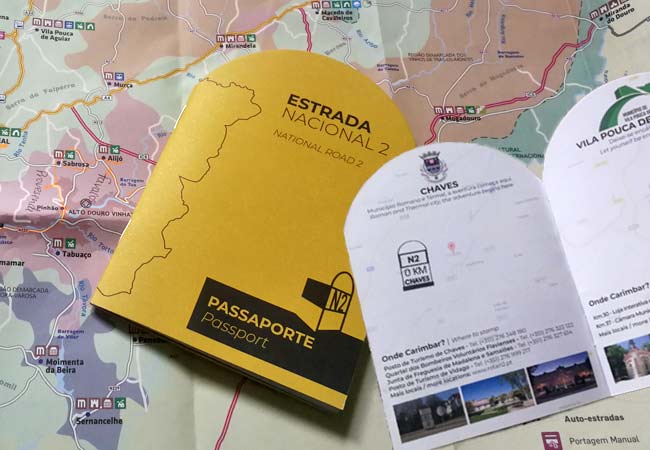
The N2 passport with the final stamp (if heading from the Algarve!) from Chaves
Highlights of the N2 Route
Lamego
Lamego is a delightful town set amidst the rolling hills of the Douro region, and in our opinion the best stop on the N2 route.
Its standout tourist attraction is the magnificent Santuário de Nossa Senhora dos Remédios, which stands atop a hill above Lamego and is reached via an impressive Baroque stairway of 686 steps. In the town itself is an ancient castle, one of Portugal's finest regional museums (the Museu de Lamego) and a Gothic cathedral. Running the length of the town is a grand avenue lined with open-air cafes, where you will find a welcoming mix of tourists and locals.
If you're planning a longer tour, Lamego would make a fantastic base from which to explore the Douro region and the N222 road.
Related articles: Lamego guide
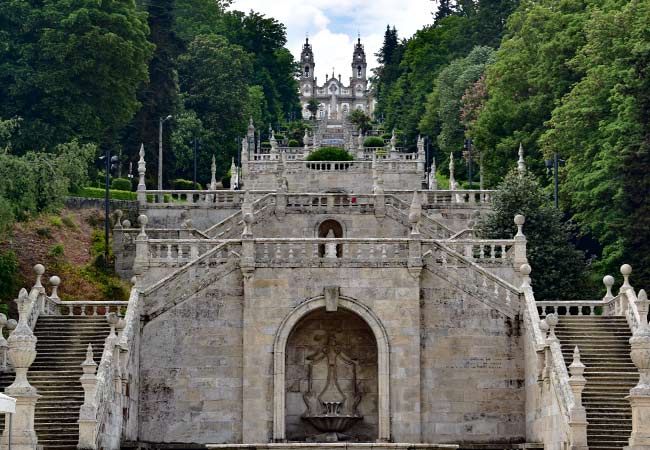
The Santuário de Nossa Senhora dos Remédios
Evora
Historic Evora is both the heart and capital city of the Alentejo region, and is well worth a detour (32km) from the N2.
During the medieval period, Evora was on the main trade route between Lisbon and Spain, and became an influential city.
The city has barely been altered since its zenith in the 16th century, with cobbled streets, a grand cathedral and solid walls that encircle the entire city. One of the most unique sights of Evora is the macabre Capela dos Ossos, a chapel lined with the bones of 5,000 bodies that were exhumed from the city's graves by Franciscan monks.
Evora boasts many restaurants and bars (in part due to its large university) along with an unhurried pace of life brought about by the region's extremely hot summers.
The city is one of the best tourist destinations of central Portugal and a highly recommended stop along the N2. For a longer tour, you could also include the highly fortified town of Elvaz, which sits on the Spanish border.
Related articles: Elvas guide
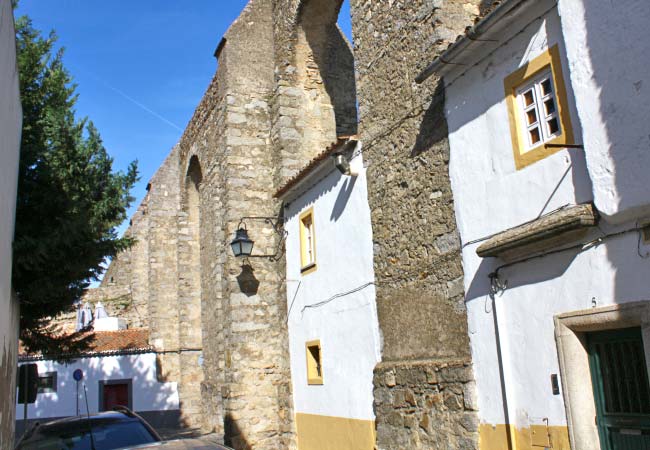
The aqueduct in Evora with houses constructed below the arches
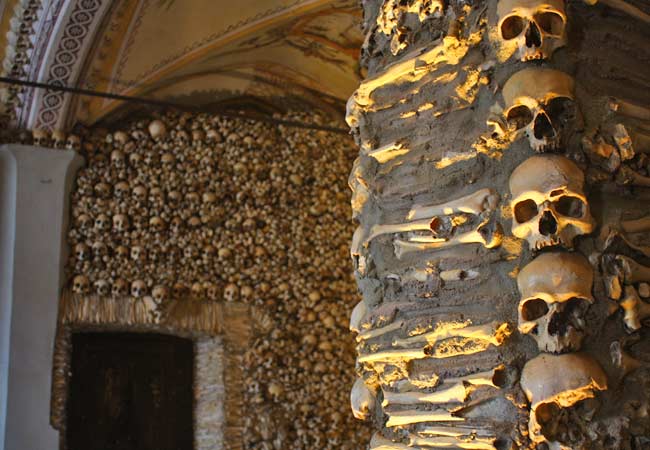
The Capela dos Ossos
Chaves
Chaves was founded by the Romans as a spa town, due to the thermal waters (at 73C) that rise up through tectonic fractures. Today the healing properties of this mineral-rich water can be experienced in the large spa complex (the Termas de Chaves), and bathing here is popular with the older Portuguese generations.
Chaves is a highly fortified town, and protected the northern route into Portugal from Spain, which lies just 9km to the north. There are massive town walls encircling Chaves, and at the top of the hill on which the town sits is an impressive medieval castle.
Chaves makes for a wonderful start or end destination for your tour along the N2 route, with its authentic Portuguese atmosphere and fewer tourists.
Related articles: Chaves guide
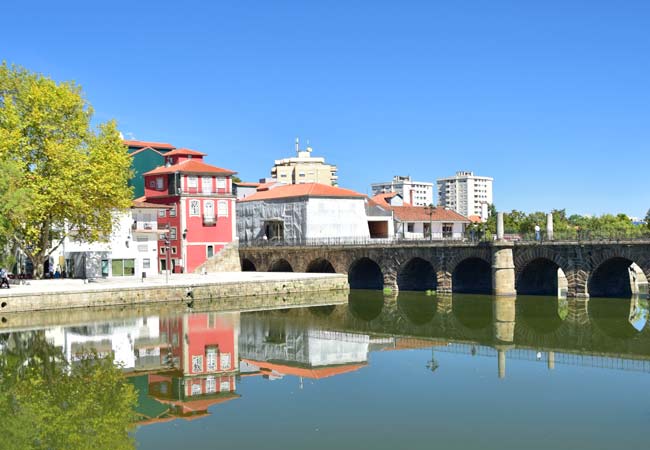
The Roman bridge crossing the Tâmega River in Chaves
Faro
Faro is one of the largest cities along the Algarve coastline. It has a delightful historic quarter, a traditional Portuguese atmosphere, along with the 738km N2 marker!
Found within Faro is a small fishing harbour, pedestrianised shopping streets, and numerous sights within the historic quarter.
For a relaxing stop during your long drive or cycle, consider the beachside village of Praia de Faro, which lies just 7km from Faro. The village has a personable and peaceful atmosphere, and is popular with the Portuguese. For a slow travel holiday, Praia de Faro is one of the best destinations in the highly touristy Algarve.
Insight: The main international airport of southern Portugal is very close to Faro. If you are planning a holiday purely around the N2, Faro is a good airport to fly into, a great location to hire a car or campervan, and ideal as a base before and after your tour.
Related articles: Faro guide
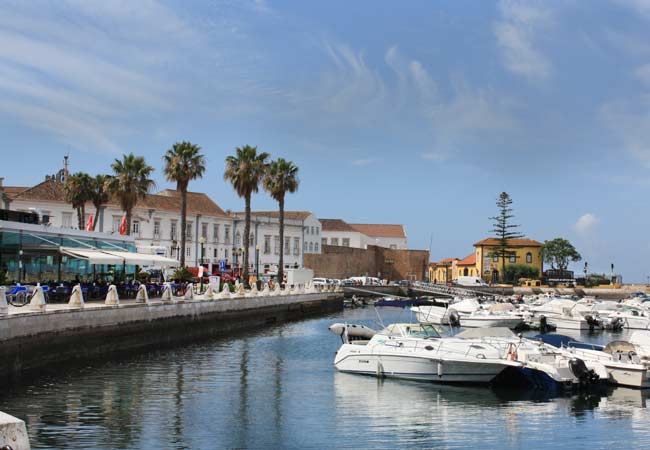
Faro harbour
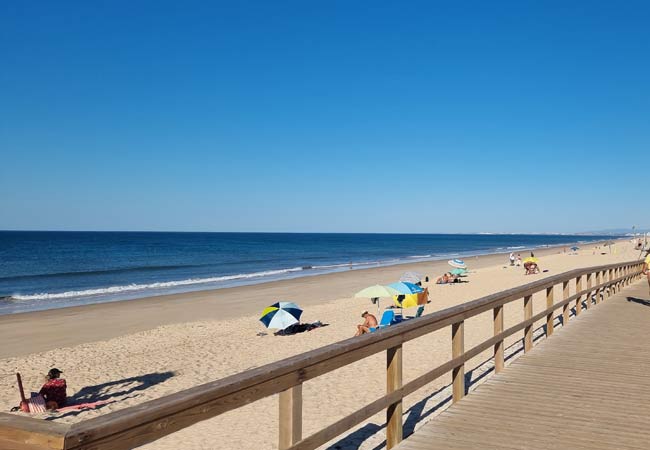
The low-key beach at Praia de Faro
Coimbra (10km from N2)
Coimbra is the university city of Portugal, offering another worthy detour from the N2 (10km) and location for a night's rest.
The city is famed for its impressive university complex, which was originally a royal palace that was gifted to the university by King João III in 1597. The complex includes a wondrous 18th century library (the Biblioteca Joanina) and tranquil gardens (Jardim Botânico da Universidade).
Coimbra is a lively and bustling city, with an atmosphere similar to that of Lisbon and Porto, making it very different from the peaceful towns found along the rest of the N2.
Related articles: Coimbra guide
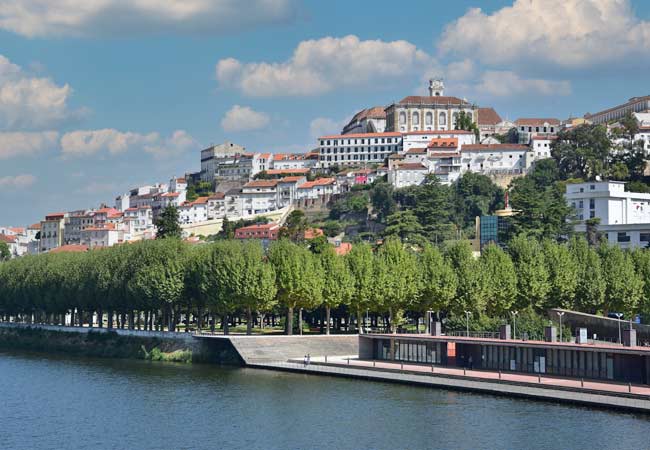
Coimbra
Viseu
Viseu is another fascinating historic city, which is very similar to Evora. However, it is barely known and seldom visited by foreign visitors.
The city is constructed from dark granite and straddles a steep hill, but unlike many other Portuguese towns has retained its medieval centre and distinctive character. At the heart of Viseu is an imposing 12th-century cathedral and an impressive baroque church, along with a museum dedicated to Vasco Fernandes - one of Portugal's most influential painters.
The city also offers good shopping, many traditional restaurants, and has styled itself as a cultural centre. But the real appeal of Viseu is the chance to visit a bustling Portuguese city that has almost no tourists. Viseu is another great base for a night's stay.
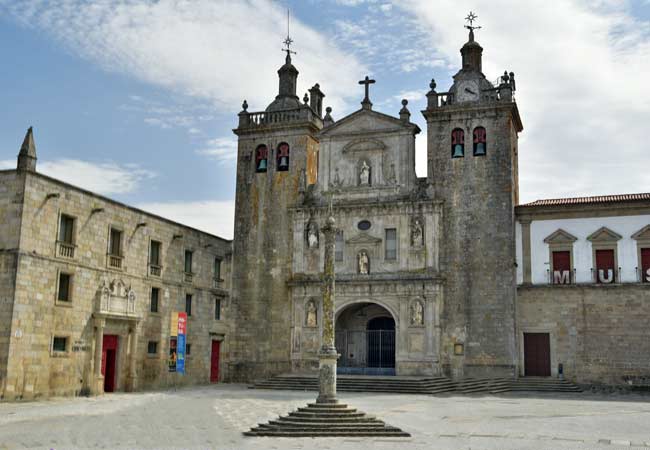
The Sé Catedral de Viseu
Peso da Régua
Peso da Régua sits on the northern banks of the Douro River and was historically a centre for wine production and transportation. The town is not the most pretty of the region (Lamego and Pinhão are much more scenic), but it is home to the informative Museu do Douro and is the best location for joining a boat cruise along the Douro River.
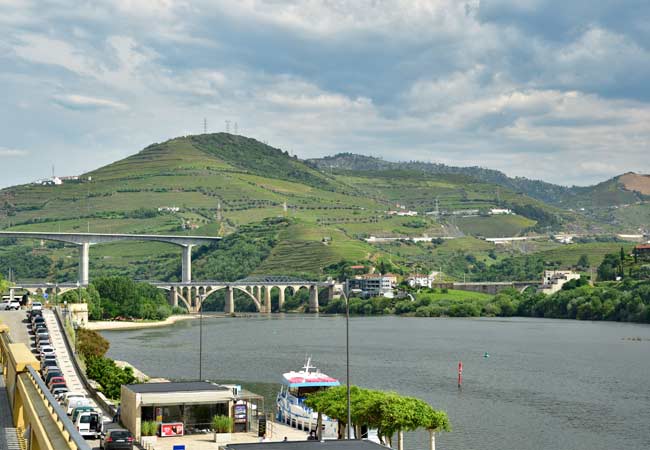
Peso da Régua lies in one of the most stunning regions of the Douro Valley
Estoi
The small village of Estoi offers an interesting stop as you enter the Algarve region. Found within the village are the Romanas de Milreu, an extensive series of Roman ruins that include a villa, temple and bath complex. Also in Estoi is the Palácio Estoi, a beautiful Rococo-styled palace that has been converted into a luxurious hotel.
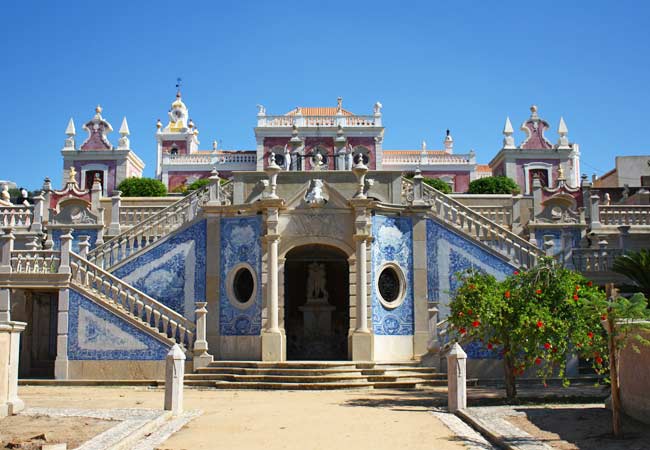
The Palácio Estoi
Mértola
The scorching summers and arid lands of the central Alentejo region mean there are few towns or sights along the N2 as it passes through this part of the country.
The best town of the southern Alentejo is Mértola, but this lies 40km to the east of the N2. Mértola sits on a cliff above the mighty Guadiana River and is a picturesque town, with a Moorish castle and plenty of Portuguese character. This is another town where you can embrace the relaxed pace of life and delicious regional cuisines of the region.

The Picoto da Melriça
The Picoto da Melriça marks the exact centre of mainland Portugal (the geodesic centre) and lies next to the N2, 3km north of Vila de Rei. This point happens to be on the highest hill in the region, where you will find wonderful views over the region's pine forests from the summit.
Abrantes
Abrantes lies along the Tejo River and is famed for its 12th-century castle. The castle was originally constructed by the Moors but was conquered in 1148 by Afonso I, the first king of Portugal.
Today this pretty town has a peaceful atmosphere and is a popular stop along the N2.





























